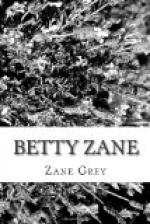The buffalo and elk were hunted with the bow and arrow. This effective weapon did not make a noise and frighten the game. The wary Indian crawled through the high grass until within easy range and sometimes killed several buffalo or elk before the herd became alarmed. The meat was then jerked. This consisted in cutting it into thin strips and drying it in the sun. Afterwards it was hung up in the lodges. The skins were stretched on poles to dry, and when cured they served as robes, clothing and wigwam-coverings.
The Indians were fond of honey and maple sugar. The finding of a hive of bees, or a good run of maple syrup was an occasion for general rejoicing. They found the honey in hollow trees, and they obtained the maple sugar in two ways. When the sap came up in the maple trees a hole was bored in the trees about a foot from the ground and a small tube, usually made from a piece of alder, was inserted in the hole. Through this the sap was carried into a vessel which was placed under the tree. This sap was boiled down in kettles. If the Indians had no kettles they made the frost take the place of heat in preparing the sugar. They used shallow vessels made of bark, and these were filled with water and the maple sap. It was left to freeze over night and in the morning the ice was broken and thrown away. The sugar did not freeze. When this process had been repeated several times the residue was very good maple sugar.
Isaac did more than his share toward the work of provisioning the village for the winter. But he enjoyed it. He was particularly fond of fishing by moonlight. Early November was the best season for this sport, and the Indians caught large numbers of fish. They placed a torch in the bow of a canoe and paddled noiselessly over the stream. In the clear water a bright light would so attract and fascinate the fish that they would lie motionless near the bottom of the shallow stream.
One cold night Isaac was in the bow of the canoe. Seeing a large fish he whispered to the Indians with him to exercise caution. His guides paddled noiselessly through the water. Isaac stood up and raised the spear, ready to strike. In another second Isaac had cast the iron, but in his eagerness he overbalanced himself and plunged head first into the icy current, making a great splash and spoiling any further fishing. Incidents like this were a source of infinite amusement to the Indians.
Before the autumn evenings grew too cold the Indian held their courting dances. All unmarried maidens and braves in the village were expected to take part in these dances. In the bright light of huge fires, and watched by the chiefs, the old men, the squaws, and the children, the maidens and the braves, arrayed in their gaudiest apparel, marched into the circle. They formed two lines a few paces apart. Each held in the right hand a dry gourd which contained pebbles. Advancing toward one another they sang the courting song, keeping time to the tune with the rattling of the pebbles. When they met in the center the braves bent forward and whispered a word to the maidens. At a certain point in the song, which was indicated by a louder note, the maidens would change their positions, and this was continued until every brave had whispered to every maiden, when the dance ended.




